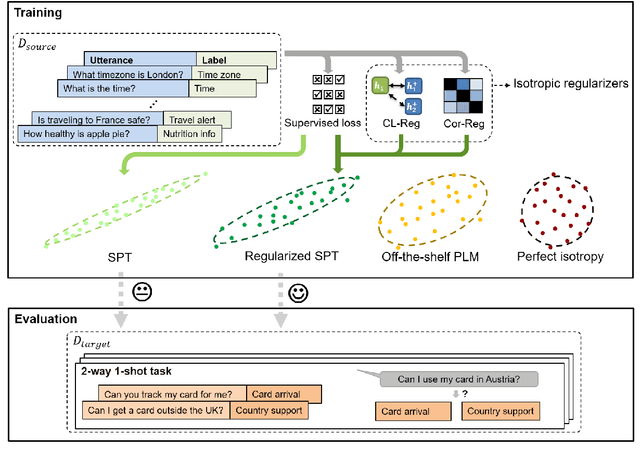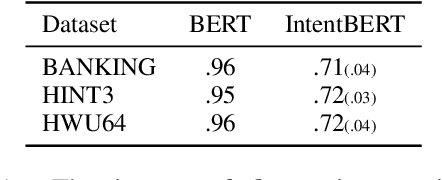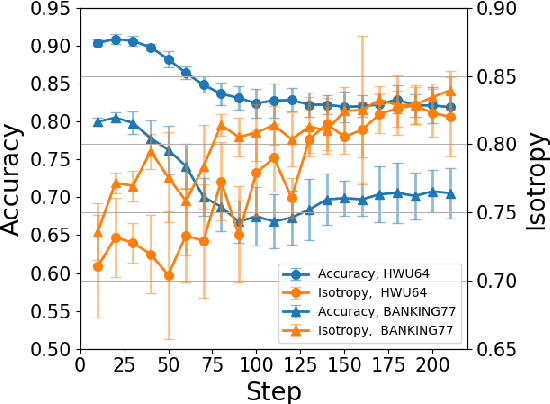Haowen Liang
Revisit Few-shot Intent Classification with PLMs: Direct Fine-tuning vs. Continual Pre-training
Jun 08, 2023Abstract:We consider the task of few-shot intent detection, which involves training a deep learning model to classify utterances based on their underlying intents using only a small amount of labeled data. The current approach to address this problem is through continual pre-training, i.e., fine-tuning pre-trained language models (PLMs) on external resources (e.g., conversational corpora, public intent detection datasets, or natural language understanding datasets) before using them as utterance encoders for training an intent classifier. In this paper, we show that continual pre-training may not be essential, since the overfitting problem of PLMs on this task may not be as serious as expected. Specifically, we find that directly fine-tuning PLMs on only a handful of labeled examples already yields decent results compared to methods that employ continual pre-training, and the performance gap diminishes rapidly as the number of labeled data increases. To maximize the utilization of the limited available data, we propose a context augmentation method and leverage sequential self-distillation to boost performance. Comprehensive experiments on real-world benchmarks show that given only two or more labeled samples per class, direct fine-tuning outperforms many strong baselines that utilize external data sources for continual pre-training. The code can be found at https://github.com/hdzhang-code/DFTPlus.
Fine-tuning Pre-trained Language Models for Few-shot Intent Detection: Supervised Pre-training and Isotropization
May 15, 2022



Abstract:It is challenging to train a good intent classifier for a task-oriented dialogue system with only a few annotations. Recent studies have shown that fine-tuning pre-trained language models with a small amount of labeled utterances from public benchmarks in a supervised manner is extremely helpful. However, we find that supervised pre-training yields an anisotropic feature space, which may suppress the expressive power of the semantic representations. Inspired by recent research in isotropization, we propose to improve supervised pre-training by regularizing the feature space towards isotropy. We propose two regularizers based on contrastive learning and correlation matrix respectively, and demonstrate their effectiveness through extensive experiments. Our main finding is that it is promising to regularize supervised pre-training with isotropization to further improve the performance of few-shot intent detection. The source code can be found at https://github.com/fanolabs/isoIntentBert-main.
Out-of-Scope Intent Detection with Self-Supervision and Discriminative Training
Jun 17, 2021



Abstract:Out-of-scope intent detection is of practical importance in task-oriented dialogue systems. Since the distribution of outlier utterances is arbitrary and unknown in the training stage, existing methods commonly rely on strong assumptions on data distribution such as mixture of Gaussians to make inference, resulting in either complex multi-step training procedures or hand-crafted rules such as confidence threshold selection for outlier detection. In this paper, we propose a simple yet effective method to train an out-of-scope intent classifier in a fully end-to-end manner by simulating the test scenario in training, which requires no assumption on data distribution and no additional post-processing or threshold setting. Specifically, we construct a set of pseudo outliers in the training stage, by generating synthetic outliers using inliner features via self-supervision and sampling out-of-scope sentences from easily available open-domain datasets. The pseudo outliers are used to train a discriminative classifier that can be directly applied to and generalize well on the test task. We evaluate our method extensively on four benchmark dialogue datasets and observe significant improvements over state-of-the-art approaches. Our code has been released at https://github.com/liam0949/DCLOOS.
 Add to Chrome
Add to Chrome Add to Firefox
Add to Firefox Add to Edge
Add to Edge